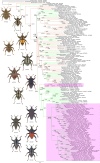Transoceanic origin of microendemic and flightless New Caledonian weevils
- PMID: 28680653
- PMCID: PMC5493895
- DOI: 10.1098/rsos.160546
Transoceanic origin of microendemic and flightless New Caledonian weevils
Abstract
The origin of the astonishing New Caledonian biota continues to fuel a heated debate among advocates of a Gondwanan relict scenario and defenders of late oceanic dispersal. Here, we study the origin of New Caledonian Trigonopterus flightless weevils using a multimarker molecular phylogeny. We infer two independent clades of species found in the archipelago. Our dating estimates suggest a Late Miocene origin of both clades long after the re-emergence of New Caledonia about 37 Ma. The estimation of ancestral ranges supports an ancestral origin of the genus in a combined region encompassing Australia and New Guinea with subsequent colonizations of New Caledonia out of New Guinea in the mid-Miocene. The two New Caledonian lineages have had very different evolutionary trajectories. Colonizers belonging to a clade of foliage dwellers greatly diversified, whereas species inhabiting leaf-litter have been less successful.
Keywords: BioGeoBEARS; Curculionidae; Melanesia; Trigonopterus; flightless beetle biogeography; long-distance dispersal.
Conflict of interest statement
We declare we have no competing interests.
Figures



References
-
- Parkinson CL, Adams KL, Palmer JD. 1999. Multigene analyses identify the three earliest lineages of extant flowering plants. Curr. Biol. 9, 1485–1491. (doi:10.1016/S0960-9822(00)80119-0) - DOI - PubMed
-
- Hackett SJ, et al. 2008. A phylogenomic study of birds reveals their evolutionary history. Science 320, 1763–1768. (doi:10.1126/science.1157704) - DOI - PubMed
-
- Lowry PP. 1998. Diversity, endemism, and extinction in the flora of New Caledonia: a review. In Proc. Int. Symp. Rare, Threatened, and Endangered Floras of Asia and the Pacific Rim. Institute of Botany, Academia Sinica Monograph Series, pp. 181–206. Taipei, Japan: Taiwan Institute.
-
- Grandcolas P, Murienne J, Robillard T, Desutter-Grandcolas L, Jourdan H, Guilbert E, Deharveng L. 2008. New Caledonia: a very old Darwinian island? Phil. Trans. R. Soc. B 363, 3309–3317. (doi:10.1098/rstb.2008.0122) - DOI - PMC - PubMed
-
- Murienne J, Guilbert E, Grandcolas P. 2009. Species' diversity in the New Caledonian endemic genera Cephalidiosus and Nobarnus (Insecta: Heteroptera: Tingidae), an approach using phylogeny and species' distribution modelling. Biol. J. Linn. Soc. 97, 177–184. (doi:10.1111/j.1095-8312.2008.01184.x) - DOI
Associated data
LinkOut - more resources
Full Text Sources
Other Literature Sources

